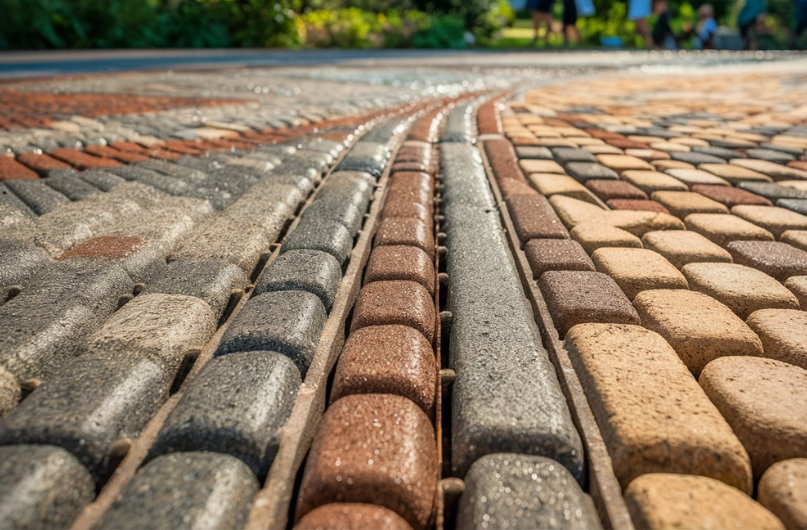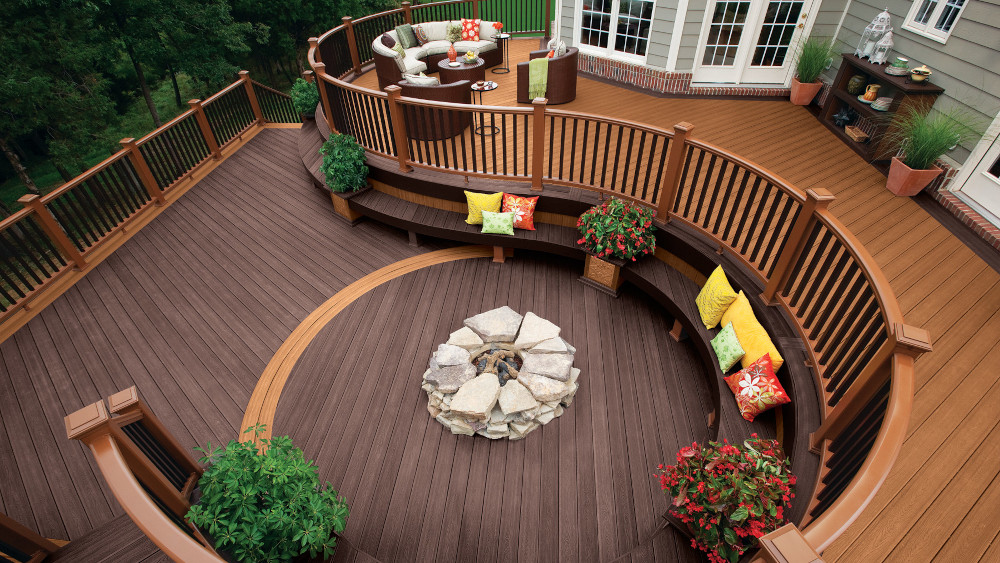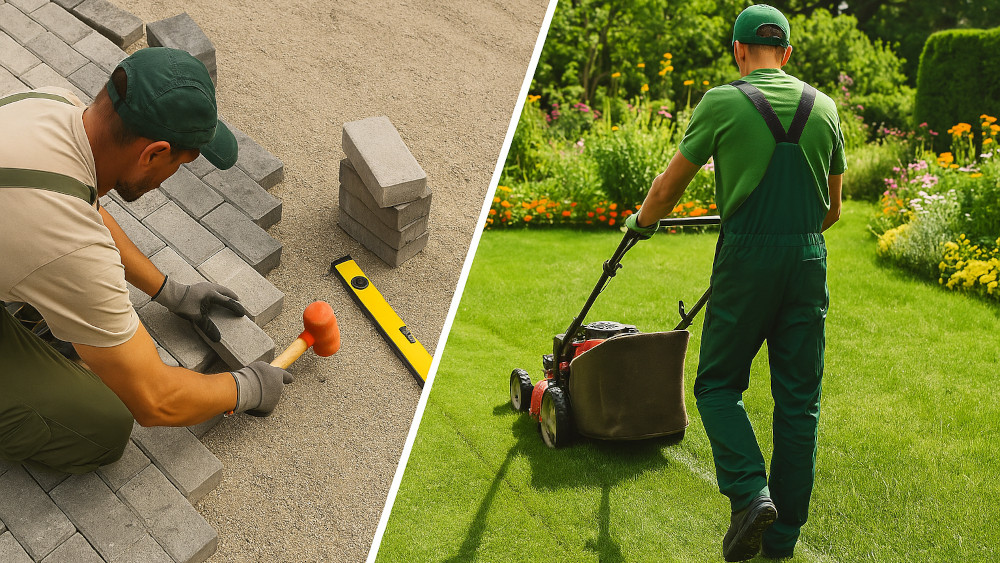Permeable paving options provide environmentally-friendly solutions for eco-conscious yards. They promote natural water infiltration, reduce surface runoff, and improve water quality. Materials like permeable concrete, porous asphalt, and interlocking pavers offer durability and effective drainage. Gravel and stone are versatile, while grass pavers support sustainable landscaping and stormwater management. Although initial costs can be higher, these materials often lead to long-term savings by reducing stormwater infrastructure needs and offering tax incentives. Integrating native plants can enrich the ecological balance. For detailed insights into selecting the right materials and optimizing benefits, further exploration can provide deeper understanding.
Main Points
- Permeable concrete allows water infiltration, offering durability and design versatility for eco-friendly yards.
- Porous asphalt is cost-effective and ideal for large areas, providing excellent water infiltration.
- Interlocking pavers come in various styles and colors, ensuring effective drainage and long-term benefits.
- Gravel and stone provide excellent drainage and are versatile for different yard designs.
- Grass pavers support sustainable landscaping and stormwater management by reinforcing lawns and promoting grass growth.
Benefits of Permeable Paving
Permeable paving offers a range of benefits that make it an attractive option for environmentally conscious homeowners.
These benefits can be categorized into environmental, economic, and aesthetic and functional advantages.
Understanding these key points will highlight why permeable paving is an increasingly popular choice for sustainable landscaping.
Environmental Benefits
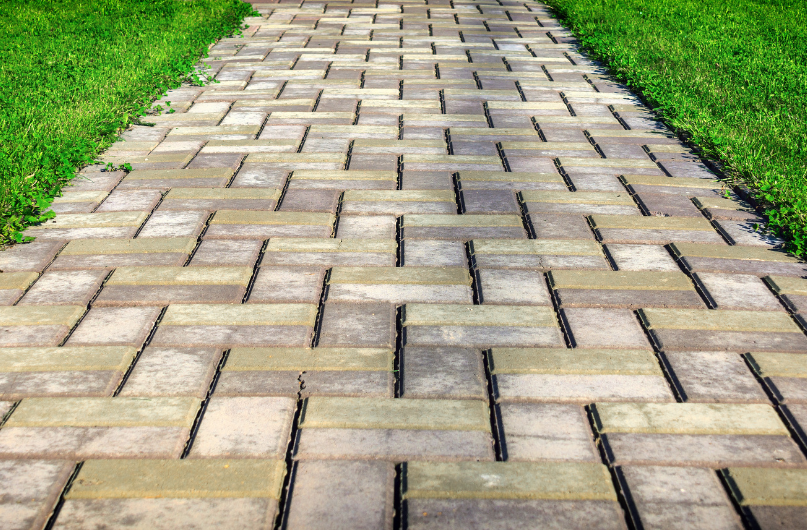
By promoting natural water infiltration, these eco-friendly paving options greatly improve water management and quality. Permeable paving facilitates rainwater harvesting by allowing water to pass through surfaces rather than running off into storm drains. This process supports green infrastructure initiatives by reducing the burden on municipal water systems and helping maintain sustainable landscaping practices.
One of the primary environmental benefits is boosted stormwater management. Permeable paving reduces surface runoff, thereby mitigating the risk of flooding, especially in high rainfall regions. This reduction in runoff not only prevents local flooding but also minimizes erosion and sediment deposition in nearby water bodies.
Furthermore, permeable paving contributes to groundwater recharge. By allowing water to seep through and percolate into the soil, these paving options replenish aquifers and maintain the natural hydrological cycle. This process is crucial for sustaining local water supplies, particularly in areas facing water scarcity.
Additionally, the filtration capabilities of permeable paving improve local water quality. As water passes through the permeable surface, pollutants and contaminants are filtered out, resulting in cleaner water entering the groundwater system. This natural filtration process enhances the overall environmental health of the local ecosystem.
Economic Benefits
In addition to the environmental advantages, permeable paving also offers significant economic benefits for both municipalities and homeowners.
One of the primary financial advantages of permeable paving is the reduced need for extensive stormwater infrastructure. By allowing water to percolate through the surface, these systems diminish the burden on public drainage systems, leading to substantial cost savings in the long term.
For homeowners, permeable paving presents economic perks through its durability and longevity. Traditional paving materials often require frequent maintenance and replacement, whereas permeable alternatives are designed to withstand adverse conditions with minimal upkeep. This translates into budget benefits, as homeowners can save on repair and replacement costs over time.
Moreover, the money-saving potential of permeable paving is underscored by its environmentally friendly nature. The sustainable design reduces the likelihood of flooding and water damage, which can incur significant expenses. Additionally, the eco-friendly attributes may qualify property owners for tax incentives or rebates, providing further financial advantages.
Aesthetic and Functional Benefits
Integrating permeable paving into outdoor spaces offers both aesthetic and functional benefits that can greatly improve the overall appeal and usability of a yard. These surfaces can serve as a source of design inspiration, offering versatile options that enrich landscape aesthetics while promoting eco-friendly practices.
Permeable paving materials come in various styles, colors, and textures, allowing homeowners to create unique, visually pleasing designs that complement their existing yard features.
From a functional perspective, permeable paving transforms yards by providing effective drainage solutions. Improved drainage reduces water pooling and mud, making outdoor areas more usable throughout the year. This practicality ensures that yards remain accessible and enjoyable, regardless of weather conditions.
Additionally, the eco benefits of these surfaces contribute to sustainable landscaping by facilitating natural water filtration and helping to prevent flooding.
The combined beauty and usability of permeable paving make it a smart choice for anyone looking to enrich their outdoor space. Not only does it provide an aesthetic appeal, but its functionality also supports sustainable practices.
Therefore, permeable paving stands out as a practical and environmentally responsible option for any yard transformation, seamlessly blending aesthetic charm with eco-conscious utility.
Types of Permeable Paving Materials
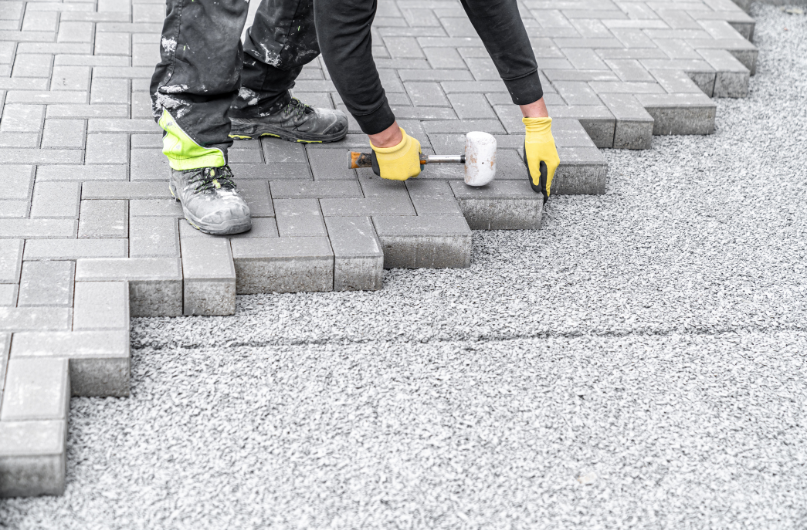
When considering permeable paving materials, several effective options are available to suit various needs and preferences. These include:
- Permeable concrete
- Porous asphalt
- Interlocking pavers
- Gravel and stone
- Grass pavers
Each type offers unique benefits regarding water permeability, aesthetic appeal, and environmental impact, making them suitable for a range of applications from residential driveways to commercial walkways.
Permeable Concrete
Permeable concrete, a type of permeable paving material, is engineered to allow water to pass through its surface, thereby reducing surface runoff and aiding in groundwater recharge. The installation process involves laying a specially formulated mix of cement, coarse aggregates, and water with little to no fine aggregates, creating a porous structure. This method requires precise mixing and expert application to guarantee proper permeability and structural integrity.
Maintenance requirements for permeable concrete are relatively low but necessary; periodic cleaning is vital to prevent clogging of the pores by dirt and debris. This can usually be achieved through pressure washing or vacuum sweeping.
Concerning longevity and durability, permeable concrete is comparable to traditional concrete, offering robust performance under typical use conditions, although it may be less suitable for extremely heavy loads.
When conducting a cost comparison, permeable concrete can be more expensive initially due to specialized materials and installation techniques. However, its long-term benefits, such as reduced water management costs and environmental advantages, often justify the investment.
Design versatility is another strength, as permeable concrete can be customized with various finishes, colors, and patterns to complement the aesthetics of any eco-friendly yard.
Porous Asphalt
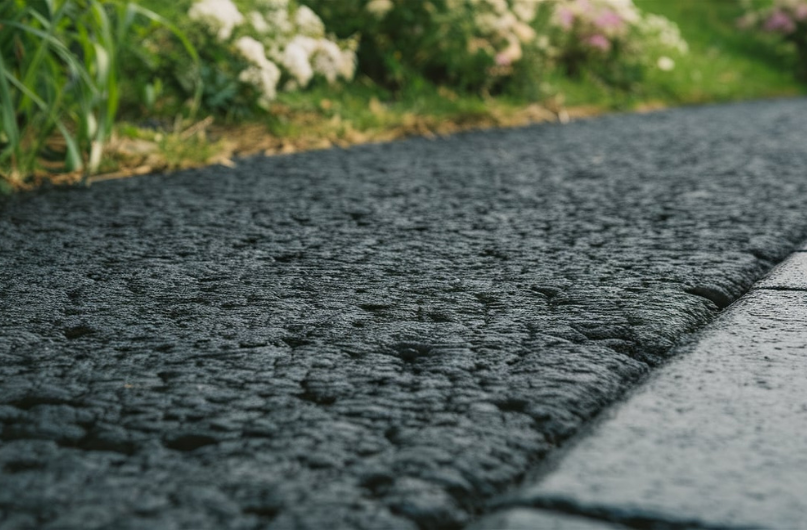
Porous asphalt stands out as a permeable paving material designed to allow water to infiltrate through its surface, distinguishing it from traditional asphalt. This innovative material is particularly effective for large driveways and parking areas, presenting a viable option for homeowners and commercial properties alike.
The installation process of porous asphalt involves laying down a specially formulated asphalt mix on a bed of crushed stone, which facilitates drainage. This method guarantees that rainwater permeates through the surface, reducing runoff and aiding stormwater management.
Maintenance requirements for porous asphalt are relatively straightforward, though periodic vacuuming and cleaning are necessary to prevent clogging of the pores. Compared to traditional asphalt, porous asphalt offers improved durability and longevity, thanks to its ability to mitigate water damage and reduce surface wear.
When contemplating cost comparison, porous asphalt is generally more cost-effective than other permeable paving options, largely due to its quick installation and lower material costs. However, the specific benefits make it a worthwhile investment.
Key points to take into account include:
- Efficient stormwater management
- Cost-effectiveness compared to other materials
- Relatively easy maintenance
- Quick and efficient installation process
- Improved durability and longevity
Understanding these aspects can assist in making an informed decision about integrating porous asphalt into eco-friendly yard designs.
Interlocking Pavers
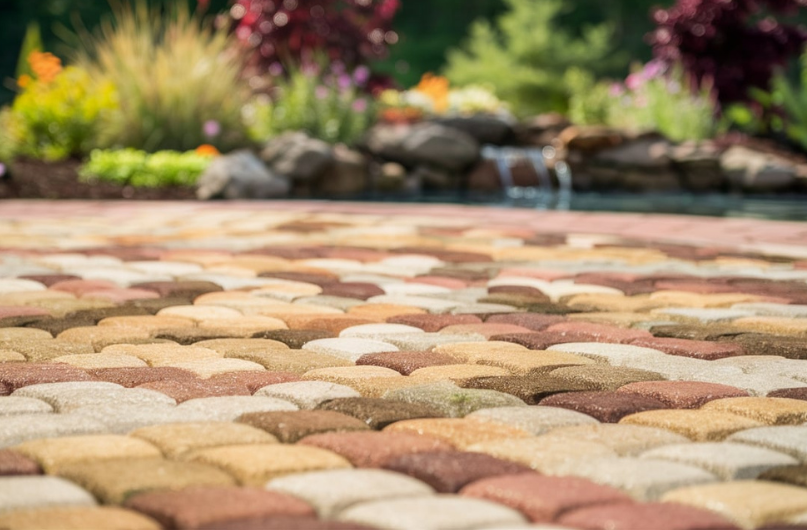
Interlocking pavers, a popular choice for permeable paving, consist of individual units that fit together to create a durable surface allowing water to pass through the joints. The installation process involves laying a base of sand and gravel, which facilitates water infiltration and guarantees a stable foundation. These pavers are particularly favored for patios, walkways, and driveways due to their robustness and aesthetic versatility.
Design options for interlocking pavers are abundant, offering a variety of colors, shapes, and patterns to suit diverse landscape styles. This flexibility allows homeowners to create visually appealing outdoor spaces while promoting eco-friendly practices.
Maintenance tips for interlocking pavers include regular sweeping to prevent debris build-up and occasional power washing to keep the surface clean. Weed growth in the joints can be mitigated with polymeric sand, which hardens upon wetting and inhibits weed germination.
When it comes to cost comparison, interlocking pavers are usually more expensive initially than traditional concrete or asphalt. However, their long-term benefits and ease of repair often justify the investment. Durability factors are also significant; these pavers withstand heavy loads and resist cracking, ensuring a longer lifespan and reduced maintenance costs over time.
Gravel and Stone
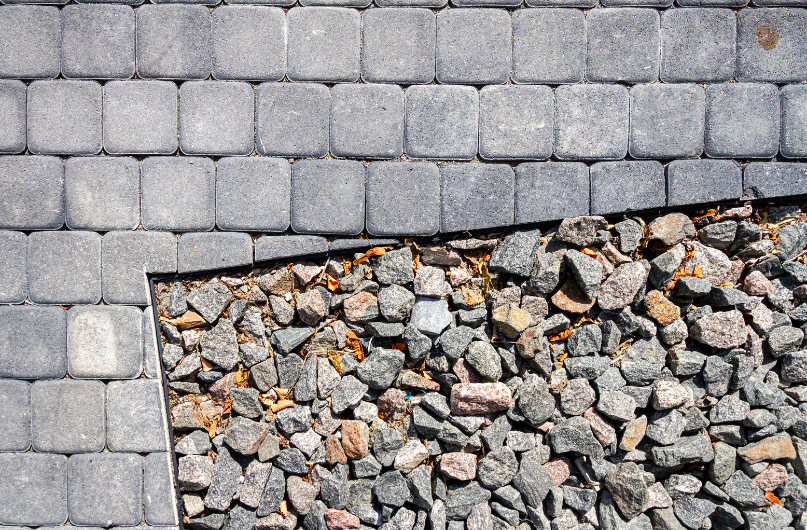
Gravel and stone are versatile materials that offer an effective solution for permeable paving in eco-friendly landscapes. These materials are not only aesthetically pleasing but also provide excellent drainage capabilities, making them ideal for garden paths, driveways, and rural properties.
Various gravel options and stone varieties exist, each with unique characteristics suited to different design needs.
To achieve the best results with gravel and stone permeable paving, consider the following:
- Gravel options: Pea gravel, crushed stone, and river rock are popular choices, each offering distinct textures and appearances.
- Stone varieties: Limestone, granite, and sandstone are commonly used, providing durability and natural beauty.
- Installation tips: Proper base preparation is essential. Use a geotextile fabric to prevent weed growth and ensure even distribution.
- Maintenance requirements: Regular raking and leveling are necessary to maintain a stable surface and prevent displacement.
- Design inspiration: Combine different gravel and stone types to create visually appealing patterns and textures that enrich your landscape’s aesthetics.
Incorporating these materials into your yard not only supports sustainable practices but also adds a timeless, natural appeal to your outdoor spaces.
Grass Pavers
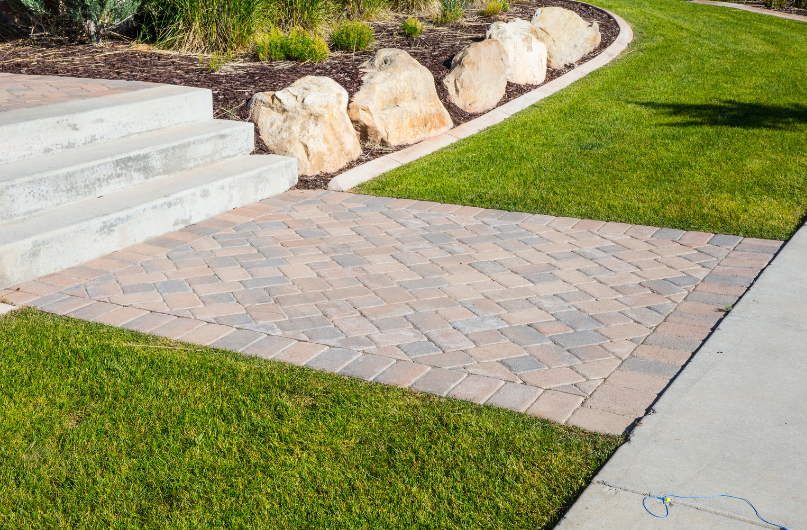
Grass pavers, often utilized in eco-friendly landscaping, are grid systems designed to support grass growth while facilitating water infiltration. These systems are integral to sustainable landscaping, offering a visually appealing solution that merges the benefits of green infrastructure with functional outdoor spaces.
Grass pavers provide lawn reinforcement, making them ideal for overflow parking, fire lanes, and low-traffic areas where maintaining a natural appearance is desired.
A primary advantage of grass pavers is their contribution to stormwater management. By allowing water to percolate through the soil, they reduce surface runoff and help manage water retention, mitigating the risk of flooding and erosion. This characteristic makes them a valuable component of any green infrastructure strategy aimed at promoting environmental sustainability.
However, potential users should be aware of some drawbacks. Over time, grass pavers may develop uneven surfaces, particularly in areas with heavy use or poor maintenance. Notwithstanding this, their eco-friendly benefits and natural aesthetics often outweigh these concerns for many homeowners committed to sustainable practices.
Implementing grass pavers can greatly improve water management efforts while providing a durable and attractive solution for various outdoor applications. This makes them an excellent choice for those seeking to balance functionality with environmental stewardship.
Considerations for New Zealand Homeowners
When considering permeable paving options, New Zealand homeowners must take into account the country’s diverse climate conditions and regional regulations. The subtropical to temperate climate variations necessitate thoughtful planning to guarantee the durability and effectiveness of these eco-friendly solutions.
Additionally, understanding local regulations and incentives can expedite the installation process and provide financial benefits.
To guarantee a successful permeable paving project, homeowners should focus on several key areas:
- Maintenance tips: Regular upkeep, such as clearing debris and periodic inspections, is crucial to maintain permeability and functionality.
- Landscaping options: Integrating permeable paving with native plants and other sustainable landscaping elements enriches the yard’s ecological balance.
- Water conservation: Permeable paving supports water conservation efforts by facilitating natural groundwater recharge and reducing runoff.
- Cost considerations: Evaluate the long-term cost benefits, including potential savings on water bills and reduced flood damage, against the initial investment.
- Installation challenges: Professional installation may be preferable to DIY approaches due to the technical expertise required to ensure proper drainage and stability.
Frequently Asked Questions
What Is the Most Eco-Friendly Paving?
The most eco-friendly paving involves using sustainable materials that promote rainwater harvesting, reduce urban heat, minimize soil erosion, and lower the carbon footprint. These innovative solutions improve environmental resilience while promoting sustainable outdoor spaces.
Is Permeable Paving Good for the Environment?
Permeable paving is beneficial for the environment, enhancing stormwater management, groundwater recharge, and soil health. It mitigates urban heat and reduces pollution, making a substantial contribution to sustainable living and superior environmental stewardship.
What Are the Best Pavers for the Environment?
The best pavers for the environment include recycled materials, natural stone, grass pavers, and porous asphalt. Additionally, local sourcing of these materials minimizes carbon footprint, enhancing sustainability and promoting eco-friendly practices in various outdoor applications.
What Are the Disadvantages of Permeable Pavers?
The disadvantages of permeable pavers include higher initial cost, increased maintenance requirements to prevent clogging issues, potential for weed growth, and limited durability under heavy traffic conditions, necessitating regular upkeep to maintain their functionality and appearance.
Conclusion
Adopting permeable paving options offers significant environmental and practical advantages for sustainable yards. These materials improve groundwater recharge, reduce runoff, and filter pollutants, thereby contributing to eco-friendly landscaping.
With various types available, homeowners can select the most suitable option for their specific needs and local conditions. By incorporating permeable paving, homeowners can create aesthetically pleasing and functional outdoor spaces while actively reducing their ecological footprint, promoting a healthier and more sustainable living environment.
